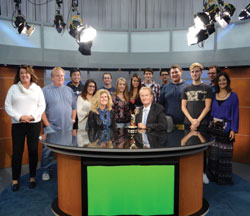According to associate professor and the station’s advisor Aaron Furgason, new equipment is scheduled to be installed by Eric Reisher, Director of Broadcast Engineering, this spring at Monmouth University’s student-run radio station, WMCX 88.9 FM.
Monmouth University’s website explains that the station, which has 1,000 watts of power and is transmitted over a 35-mile radius, features newscasts, talk shows, sporting events, and interviews, all conducted by students from different years and a variety of majors.
The current boards in both the on-air studio and production room are over 20 years old, according to Furgason, who said, “It’s amazing it lasted this long…this technology has run its lifecycle.”
Reisher explained, “[The technology] is always working and looking brand new as a result of thorough care and attention from me for the past two decades, but the reality is this stuff doesn’t last forever.”
Furgason said that the University will fund the new equipment. He elaborated, “[There was] ongoing conversation about technology that had been running non-stop for twenty-plus years and might need to be replaced soon. Gratefully, they also saw the need to replace it.” As a result of bringing in new equipment, Furgason said, “It is current technology, so it will make it simpler to be in that room.”
Ava Hubinger, sophomore Health Studies major and WMCX executive board member, explained, “I’m very excited to get new equipment for the X. I am only a sophomore, so I have not been around the equipment for a long time, but I think having new equipment will bring about many new creative opportunities and possibilities.”
Hubinger said that she looks forward to creating more space in the on-air studio. According to her, the new equipment will allow for the opportunity of more guests and additionally give a fresh feel to the studio.
With the implementation of this new equipment, students are looking forward to benefiting from these new upgrades. Bailey Fredericks, a senior communication major, said, “I’m happy it will free up some space because it’s so jammed in there. I also hope to actually be able to see my co-host while we are on air if there is more space.”
Fredericks also added, “I’m looking forward to learning how to work the new equipment to optimize my show.”
Dean Heidel, a junior communication major, also explained, “I feel it can add a lot to what we do, especially as a production manager. It can make the process of uploading and making content quicker and more effective.”
While there are many things to look forward to with the installation of the new equipment, Hubinger raised concerns in regard to relearning a whole new setup. She explained, “As I just got familiar with the old equipment, it will take some time getting adjusted to the new stuff.”
Furgason said that he will combat these concerns by retraining everyone on the new equipment. He said, “I see this not as a challenge but as an opportunity for students to learn and develop their skills.”
While the equipment has been in Reisher’s possession since the fall, the setup is scheduled to be completed this spring due to the equipment’s tedious installation and programming processes, according to Reisher. The station is set up through an intricate system of punch blocks and trunk cables that send signals throughout the building. While the new equipment does have a much simpler setup, involving a Cat-5 data cable (Ethernet cable) and a network of nodes, this makes it less work to deploy. Nevertheless, it is still an entirely new programming system to learn. Therefore, as a one-man show, it will take some time for Reisher to work out the kinks to ensure a smooth transfer from one piece of equipment to the next.
Hubinger concluded, “I want to thank Professor Furgason and Professor Reisher for the new equipment because they fight really hard for us to have the latest and greatest stuff. They truly have love for us and want the utmost success for the radio station, and I couldn’t be more grateful for them. I also want to thank the University for funding the new equipment that will keep our station going and allow us the tools we need to succeed.”




